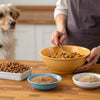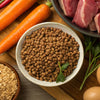How Is Dog Food Kibble Made? A Deep Dive into the Production Process
- Houndsy
Table of Contents
- Introduction
- Understanding Dog Food Formats
- Ingredient Selection and Sourcing
- The Kibble Production Process
- Pet Food Safety and Quality
- Conclusion
Introduction
Have you ever glanced at the back of your dog’s kibble bag and wondered just how those little morsels were made? You’re not alone. In fact, according to a study, over 70% of pet owners are curious about the ingredients and processes that go into their pets' food. Understanding the production of dog food kibble is crucial for ensuring our furry friends receive a balanced diet that supports their health and well-being.
In this blog post, we will explore the entire journey of kibble production, from ingredient selection to the final packaging. By the end of this article, you will have a comprehensive understanding of how dog food kibble is made, the importance of each step in the process, and how you can make informed choices for your pet’s nutrition.
We’ll cover the following aspects:
- The variety of dog food formats
- Ingredient selection and sourcing
- The process of making kibble, including cooking and cooling
- The significance of packaging and distribution
- Safety and quality standards in pet food production
As we delve into these topics, we invite you to reflect on your own pet feeding routines. Are you confident in the quality of kibble you offer your dog? Let’s find out together how the food they eat is created, and how innovations like the Houndsy Kibble Dispenser can enhance this experience.
Understanding Dog Food Formats
Before we dive into the specifics of kibble production, it’s essential to understand the different formats of dog food available today. These formats generally include:
- Dry Food (Kibble): The most popular choice among dog owners, dry food is convenient and often more affordable. Kibble has a long shelf life, making it a practical option for busy pet owners.
- Wet Food: Typically found in cans or pouches, wet food is often more palatable for dogs and can be beneficial for hydration. However, it usually has a shorter shelf life once opened.
- Raw and Freeze-Dried Food: These options are often marketed as more natural and are popular among owners seeking to mimic a dog’s ancestral diet. However, they require careful handling and storage.
- Cold-Pressed Food: A newer method that preserves nutrients by using lower temperatures during the production process.
Each format has unique production methods and nutritional profiles. However, in this post, our focus will primarily be on dry food, specifically kibble, which is the most widely consumed type.
Ingredient Selection and Sourcing
The journey of dog food kibble begins with carefully selecting ingredients. This step is crucial as it sets the foundation for the nutritional value of the final product. Ingredients can be broadly categorized into:
- Animal Proteins: Sources like chicken, beef, and fish are commonly used. These proteins can come from whole meats or rendered meals, which are by-products of the human food industry that are fit for animal consumption.
- Grains and Carbohydrates: Ingredients like rice, corn, and potatoes serve as energy sources. They help create a balanced diet and are often used in kibble formulations.
- Fruits and Vegetables: These ingredients provide essential vitamins and minerals. Common ones include carrots, blueberries, and spinach.
- Fats and Oils: Healthy fats are crucial for a dog’s skin and coat health. These can be sourced from animal fats or plant-based oils.
- Vitamins and Minerals: To ensure a complete and balanced diet, vitamins and minerals are often added to dog food to meet nutritional requirements.
At Houndsy, we prioritize quality and reliability in our products. We believe that the best kibble starts with the best ingredients. That’s why our commitment to convenience and design excellence extends to ingredient sourcing, ensuring a nutritious meal for your pet.
The Kibble Production Process
1. Ingredient Preparation
Once the ingredients are selected, they undergo rigorous preparation. This includes grinding and mixing dry ingredients, and ensuring that wet ingredients are ready for incorporation into the kibble mixture. For example, grains might be milled to the appropriate consistency, while meat products are processed to remove undesirable parts.
2. Mixing and Conditioning
The next step is combining the dry and wet ingredients into a dough-like mixture. This is where water and steam are added to hydrate the ingredients, creating a homogenous mixture. Conditioning is vital as it ensures that each component is evenly distributed, leading to uniform kibble production.
3. Extrusion
Extrusion is the heart of kibble production. The conditioned dough enters an extruder, a machine designed to cook the mixture under high pressure and temperature. Here’s how it works:
- The dough is pushed through a die, which shapes it into the desired kibble form.
- As the dough exits the extruder, the pressure drops, causing the mixture to expand and take shape, resembling the kibble we see in bags.
This process is crucial for creating consistent kibble sizes and shapes, which can vary based on the specific product formulation.
4. Drying and Cooling
After extrusion, the freshly formed kibbles are subjected to a drying process. This step is essential for removing moisture, which helps prevent spoilage and ensures a longer shelf life. The kibbles are then cooled to stabilize their structure and prepare them for coating.
5. Coating
Once cooled, the kibbles often enter a rotating drum where they are coated with flavor enhancers and preservatives. This step is critical for improving taste and ensuring freshness throughout the product’s shelf life. Coatings may include oils or fat-based flavorings that appeal to dogs.
6. Packaging
Finally, the kibble is weighed, packaged, and sealed to prevent contamination. Packaging plays a vital role in maintaining the integrity of the food, and at Houndsy, we ensure that our kibble is packaged in a way that is both functional and visually appealing.
7. Storage and Distribution
After packaging, the kibble is stored appropriately before being distributed to retailers or directly to customers. Proper storage conditions are essential to maintain the quality of the food until it reaches your home.
Pet Food Safety and Quality
Ensuring the safety and quality of pet food is paramount. All manufacturers, including those of dry dog food, must adhere to strict regulations and quality standards, which can vary by country. In the U.S., the Food and Drug Administration (FDA) and the Association of American Feed Control Officials (AAFCO) set guidelines that help maintain safety in pet food production.
Quality control measures often include:
- Regular inspections of facilities
- Testing ingredients for contaminants
- Monitoring production processes to ensure consistency
At Houndsy, our commitment to pet well-being and integrity means we uphold the highest safety standards throughout our kibble production process.
Conclusion
Understanding how dog food kibble is made gives us valuable insights into what our pets are eating every day. From ingredient sourcing to production and packaging, each step plays a crucial role in ensuring that our furry friends receive a balanced and nutritious diet.
As we aim to simplify and elevate your dog feeding experience, we invite you to explore our flagship product, the Houndsy Kibble Dispenser. Not only does it provide perfect portions every time, but its mid-century modern design also complements your home decor beautifully. By choosing Houndsy, you're not just elevating your dog's feeding experience; you're making a statement about quality and design.
Have you considered how your dog’s kibble aligns with their nutritional needs? Are you ready to enhance your pet's feeding routine? Let us help you make that transition smooth and enjoyable.
FAQ
1. What is the difference between complete and complementary dog food?
Complete dog food contains all the necessary nutrients for a dog’s daily diet, while complementary food, such as treats, needs to be fed alongside other food sources to provide balanced nutrition.
2. Why is kibble the most popular choice among dog owners?
Kibble is convenient, cost-effective, and has a long shelf life, making it a practical option for busy pet owners.
3. How can I ensure I’m buying quality kibble for my dog?
Look for brands that prioritize ingredient quality, have transparency in their sourcing, and adhere to safety standards. Reading labels and understanding the ingredients can also help.
4. What should I consider when transitioning my dog to a new kibble?
Gradually introduce the new kibble by mixing it with your dog’s current food over a week or two. Monitor your dog for any adverse reactions or changes in appetite.
5. How does the Houndsy Kibble Dispenser enhance the feeding experience?
Our dispenser features a convenient crank at standing height, allowing you to serve perfect portions without bending, and its stylish design ensures it fits seamlessly into your home decor. Explore it here.












